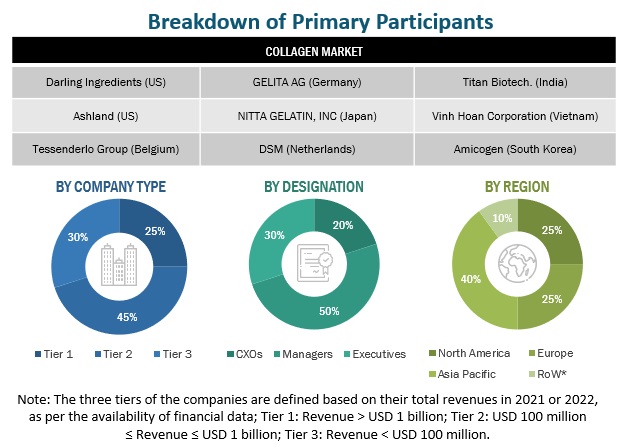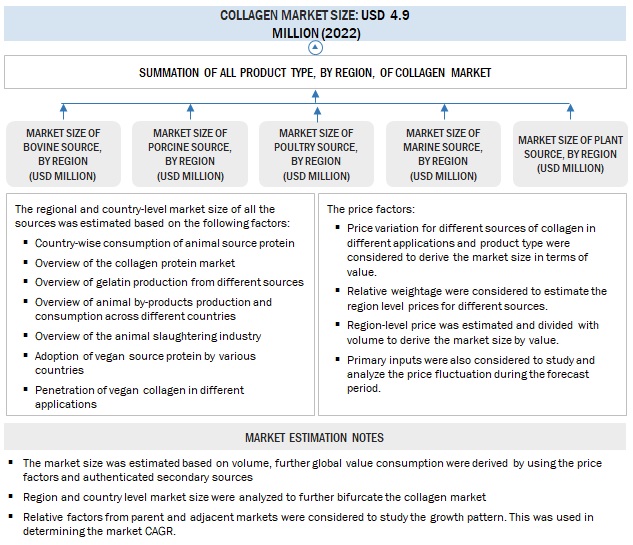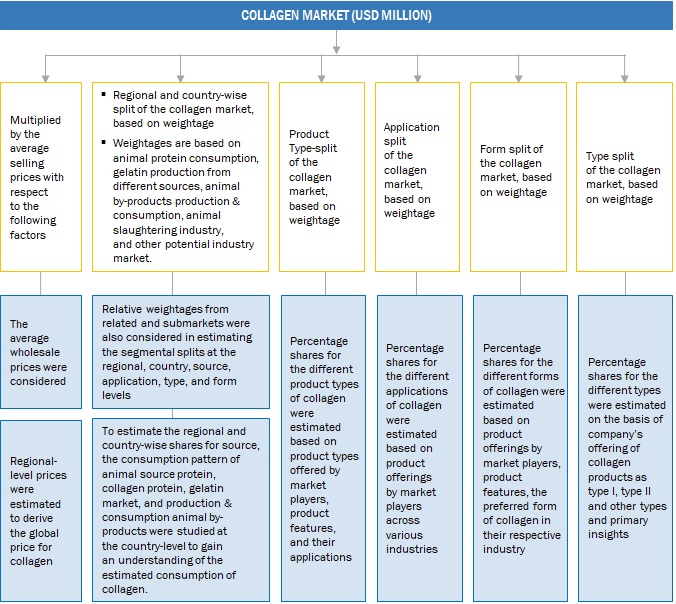The study involved five major segments in estimating the current size of the collagen market. Exhaustive secondary research was done to collect information on the market, peer, and parent markets. The next step was to validate these findings, assumptions, and sizing with industry experts across the value chain through primary research. Both top-down and bottom-up approaches were employed to estimate the complete market size. After that, market breakdown and data triangulation were used to estimate the market size of segments and subsegments.
Secondary Research
This research study involved the extensive use of secondary sources—directories and databases such as Bloomberg Businessweek and Factiva—to identify and collect information useful for a technical, market-oriented, and commercial study of the collagen market.
In the secondary research process, various sources such as annual reports, press releases & investor presentations of companies, white papers, food journals, certified publications, articles from recognized authors, gold & silver standard websites, directories, and databases, were referred to identify and collect information. This research study involved the extensive use of secondary sources—directories and databases such as Bloomberg Businessweek and Factiva—to identify and collect information useful for a technical, market-oriented, and commercial study of the collagen market.
Secondary research was mainly used to obtain key information about the industry’s supply chain, the total pool of key players, and market classification and segmentation as per the industry trends to the bottom-most level, regional markets, and key developments from both market- and technology-oriented perspectives.
Primary Research
Extensive primary research was conducted after obtaining information regarding the collagen market scenario through secondary research. Several primary interviews were conducted with market experts from both the demand and supply sides across major countries of North America, Europe, Asia Pacific, South America, and the Rest of the World. Primary data was collected through questionnaires, emails, and telephonic interviews. The primary sources from the supply side included various industry experts, such as Chief X Officers (CXOs), Vice Presidents (VPs), Directors, from business development, marketing, research, and development teams, and related key executives from distributors, and key opinion leaders. Primary interviews were conducted to gather insights such as market statistics, data on revenue collected from the products and services, market breakdowns, market size estimations, market forecasting, and data triangulation. Primary research also helped in understanding the various trends related to collagen products, product types, application, source, form, type, extraction process and region. Stakeholders from the demand side, such as collagen companies who manufacture the collagen were interviewed to understand the buyer’s perspective on the suppliers, products, and their current usage of collagen products and the outlook of their business which will affect the overall market.

To know about the assumptions considered for the study, download the pdf brochure
Coolagen Market Size Estimation
Both the top-down and bottom-up approaches were used to estimate and validate the total size of the collagen market. These approaches were also used extensively to determine the size of various subsegments in the market. The research methodology used to estimate the market size includes the following details:
-
The key players in the industry and the overall markets were identified through extensive secondary research.
-
All shares, splits, and breakdowns were determined using secondary sources and verified through primary sources.
-
All possible parameters that affect the market covered in this research study were accounted for, viewed in extensive detail, verified through primary research, and analyzed to obtain final quantitative and qualitative data.
-
The research included the study of reports, reviews, and newsletters of top market players, along with extensive interviews for opinions from leaders, such as CEOs, directors, and marketing executives.
Global Collagen Products Market: Bottom-Up Approach

Global collagen Market: Top-Down Approach

Data Triangulation
After arriving at the overall market size from the estimation process explained above, the total market was split into several segments and subsegments. Data triangulation and market breakdown procedures were employed to estimate the collagen market and arrive at the exact statistics for all segments and subsegments. The data was triangulated by studying numerous factors and trends from the demand and supply sides. The market size was also validated using both the top-down and bottom-up approaches.
Market Definition
-
Collagen is one of the key structural proteins found in the extracellular matrices of many connective tissues in mammals, making up about 25%–35% of the whole-body protein content. It is mostly found in fibrous tissues such as tendons, ligaments, and skin (about one-half of total body collagen) and is abundant in corneas, cartilage, bones, blood vessels, and the gut.
-
Gelatin is obtained by the partial hydrolysis of collagen. This process occurs when collagen triple helices are broken down to the point of being pulled apart into individual strands. Gelatin will only dissolve in hot water and jellify when cooled. Due to its gelling, foaming, emulsifying, and binding functions, gelatin is often used in culinary applications, such as gummy candies, jellies, and sauce thickeners. Gelatin also has an irreplaceable role in pharma applications, where it is often used as an excipient for making soft and hard capsules.
Key Stakeholders
-
Manufacturers, dealers, and suppliers of collagen
-
Technology providers to collagen manufacturers
-
Food & beverage, pharmaceuticals, and cosmetics & personal care products manufacturers
-
Raw material suppliers
-
Trade associations and industry bodies
-
Importers and exporters of collagen
-
Associations. regulatory bodies, and other industry-related bodies
-
US Food and Drug Administration (US FDA)
-
Gelatine Manufacturers of Europe (GME)
-
US Department of Agriculture (USDA)
-
European Food Safety Authority (EFSA)
-
The International Food Additives Council (IFAC)
-
Food Processing Suppliers Associations (FPSA)
-
Center for Innovative Food Technology (CIFT)
-
European Food Information Council (EUFIC)
Report Objectives
-
To determine and project the size of the collagen market with respect to the product type, application, source, form, type, extraction process (Qualitative), and region in terms of value and volume over seven years, ranging from 2023 to 2030.
-
To identify the attractive opportunities in the market by determining the largest and fastest-growing segments across regions
-
To provide detailed information about the key factors influencing market growth (drivers, restraints, opportunities, and challenges)
-
To analyze the opportunities in the market for stakeholders and provide details of the competitive landscape for market leaders.
-
To analyze the micro-markets with respect to individual growth trends, prospects, and their contribution to the total market.
-
To identify and profile the key players in the collagen market.
-
To understand the competitive landscape and identify the major growth strategies adopted by players across the key regions.
-
To provide insights on key product innovations and investments in the collagen market.
Available Customizations:
With the given market data, MarketsandMarkets offers customizations according to company-specific scientific needs.
The following customization options are available for the report:
Product Analysis
-
Product Matrix, which gives a detailed comparison of the product portfolio of each company.
Geographic Analysis
With the given market data, MarketsandMarkets offers customizations according to company-specific scientific needs.
-
Further breakdown of the Rest of Europe into Netherlands, Belgium, Russia, Sweden, and other EU & non-EU countries.
-
Further breakdown of the Rest of Asia Pacific collagen market into Thailand, the Philippines, Malaysia, Singapore, and Vietnam.
-
Further breakdown of the Rest of South American collagen market into Chile, Colombia, Paraguay, and other South American countries.
Company Information
-
Detailed analyses and profiling of additional market players (up to five)



Growth opportunities and latent adjacency in Collagen Market